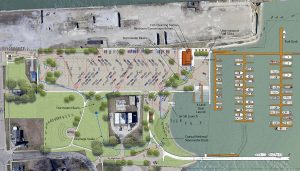
The “Big Three” of Environmental Permitting and Compliance
Published on August 15, 2023The “P” word. It is a necessary component of nearly every marina project, yet frequently evaded, disregarded, and largely disliked. Permitting can be cumbersome, no question, and the list of regulatory agencies that need to be engaged can be long. But permits are essential to the safe, sound, and sustainable operation of marinas and waterfront facilities — and the protection of the surrounding waters and environments we hold dear. So where do marina owners begin when it comes to acquiring the permits they need? In their own back yard.
Permitting begins at the state and local level. Yet, regulations vary wildly between jurisdictions and across state lines, so marinas need to research the subtle nuances of their governing agencies before getting to work. When it comes to environmental permits, a good place to begin is by addressing the “big three” of regulatory compliance: air, stormwater, and wastewater/waste.
Air
Generally speaking, there are few impacts to air quality at commercial marinas since the services of boat launches, storage, support facilities, and fueling stations are relatively benign. This can change if a marina is very sizable and offers multiple fuel pumps. It can also change if a marina is co-located with industrial or manufacturing facilities, materials handling locations, or others with industrial activity.
But there are other components of an operation that could trigger the need for air emissions permits, too: emergency generators with internal combustion engines, maintenance and service shops with comfort heating (i.e. natural gas), radiators used for freeze prevention, diesel lift cranes inside of buildings, or shrink-wrapping services that emit volatile organic compounds (VOCs) and other potentially harmful particulates. Boat paint booths might also trigger the need for a permit, depending on the size of operation, the amount of product used per year, and whether an enclosed ventilation and filtration system is in place.

So, how does a marina know if they need to pursue permitting or not? By conducting a thorough and honest inventory of all possible carbon-emitting locations and utilizing an emissions calculator to compare the facility’s potential-to-emit (PTE) numbers against state limits.
Ultimately, the regulation of air pollutants is governed by the Environmental Protection Agency (EPA) Clean Air Act (CAA) which establishes a variety of permitting programs designed to carry out the goals of the act, some run by regional EPA offices, but many others by state and local agencies. To find permitting authorities per state or region, the EPA has developed a handy “CAA Permitting Around the Nation” map, which provides program contact information, focus topics, and more.
Stormwater
There are two primary buckets within the stormwater permitting category: construction and operations.
Prior to moving any dirt or beginning construction, marinas are often required to develop a Stormwater Pollution Prevention Plan (SWPPP) in order to obtain a general construction stormwater permit through the state. Requirements may differ based on the size of the project and the amount of acreage impacted, and some states also require filing a notice of intent application to gain coverage under the permit. This general construction permit is essentially a “living” document, meaning that it gets updated as construction progresses to document any earth that is disturbed, stabilized, vegetated, or paved over until all construction elements affecting stormwater are stabilized and final.
The operations stage covers activities that transpire at the site while in use. This is where Standard Industrial Classification (SIC) codes or North American Industry Classification System (NAICS) codes come into play. Each code pertains to a different type of business operation, industrial application, manufactured product, technology, service, or trade. Typically, any “industrial” type of activity that impacts stormwater will require a stormwater permit.
Some states cover stormwater under a general permit; others require site-specific coverage as well. Such permits remain in place as long as a facility is in operation and, in many states, the facility gets inspected for stormwater compliance on a regular basis. The cadence of inspection varies greatly. In locations along a coast or a stream, rules are more stringent, and inspections more frequent — sometimes even monthly. State agencies will also consider the size and condition of the receiving body of water when deciding how stringent the permit and how frequently the site gets inspected. For example, if a water body is classified as 303(d) impaired waters by the EPA Clean Water Act, there are more rigorous limitations for Total Maximum Daily Loads (TMDLs) that must be adhered to. Different regulations also apply to large bodies of water with more dilution capacity such as the Great Lakes, or to freshwater, brackish and seawater. In areas where multiple water bodies intersect, a marina may find itself with multiple types of permits and regulations to follow.

Wastewater, Solid Waste & Hazardous Waste
The third category of regulatory compliance addresses waste — wastewater/sanitary sewer systems, solid waste, universal waste, and hazardous waste — or any byproducts generated by the operation of the facility.
For wastewater/sanitary sewer systems only (i.e. restrooms and boat pump-out stations), marinas and waterfront facilities tend to have two options: tie into the local municipal water treatment system or implement a private on-site treatment system. The option to discharge into an existing municipal system is generally only available in more sizable communities. This does require obtaining a permit with the city or receiving utility and use is limited to a pre-determined number of gallons per month/year, etc. For marinas in smaller or more remote locations, this option is likely not available. In that case, an on-site treatment system is the next-best alternative. Here, permits must be acquired through the state permitting agency for the final discharges from the system and marinas must have a certified wastewater treatment plant operator directly on staff or under contract available to sample, monitor, and treat all generated wastewater before it can be safely released into the environment.
Solid waste is a byproduct of almost every operation and covers things from general household/office garbage to items classified as hazardous materials. As a commercial or industrial facility (as opposed to a home), solid waste is regulated and thus requires registration as a solid waste generator with the state.
Solid wastes classified as universal or hazardous are highly regulated and governed much differently than standard solid waste. These byproducts are considered a threat to human health and the environment if not properly managed and must follow the “cradle to grave” program created by the Resource Conservation and Recovery Act (RCRA) to assure proper handling from generation through transportation and ultimate recycling, disposal, or treatment of the product. At marinas, some commonly classified hazardous wastes might include used oil, generators, antifreeze, oily bilge water, spent fluorescent bulbs, epoxy resins, electronics, contaminated soils, gasoline, solvents, or paints, to name a few.
All facilities generating hazardous waste must report to the EPA and acquire hazardous waste ID numbers to use for labeling and shipping. Federal regulations also require organizations to notify their local emergency planning commissions, fire departments, and first responder units — sometimes even local and state police departments — as well as neighboring residents so everyone in the immediate vicinity is aware of the potential impacts, control methods, and emergency response requirements if needed.

Compliance Success
New-build and marina renovation projects require accumulating a hefty stack of permits. Acquiring them too late, under-preparing for their application, or neglecting to secure them all together can mean huge losses in project progress or business-crippling fines for non-compliance — not to mention, detrimental impacts to the healthy environment and clean water this industry relies upon.
Marinas should begin seeking permits as soon as the concept design is complete, armed with comprehensive details about project size, operations, inputs/outputs, and potential environmental impacts. The process takes time and patience. This is where hiring a third-party consultant can be immensely helpful in navigating the proper channels of paperwork and making sure every permit is secured for project delivery and long-term success.
Editor’s Note: To learn more about the broader permitting acquisition process for marinas and waterfront facilities, read Understanding the Marina Permitting Acquisition Process on marinadockage.com.
Dan Williams, PLA, ASLA, AHLP is senior landscape architect at MSA. He can be reached at dwilliams@msa-ps.com. Jeffrey McBride is chief executive officer at Odyssey EHS Strategies, LLC. He can be reached at jeffrey@odysseyehs.com. Matt Mixon is chief operating officer at Odyssey EHS Strategies, LLC. He can be reached at matt@odysseyehs.com .
| Categories | |
| Tags |




